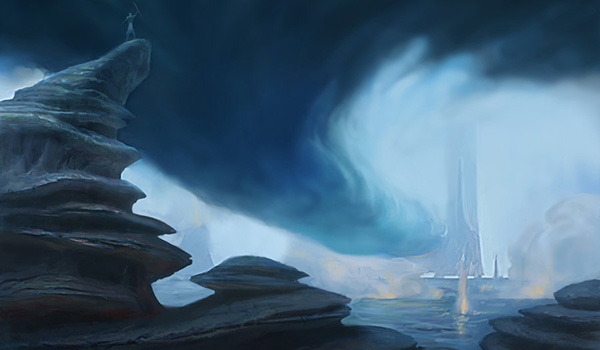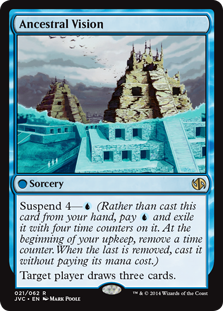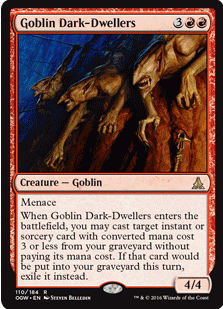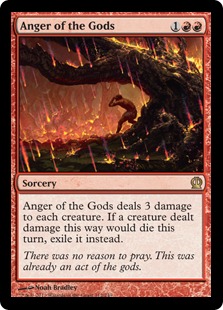Are you a Quiet Speculation member?
If not, now is a perfect time to join up! Our powerful tools, breaking-news analysis, and exclusive Discord channel will make sure you stay up to date and ahead of the curve.
Grixis Control has received a surprising amount of attention recently, due in large part to Corey Burkhart’s continued work on the archetype, and Shaheen Soorani’s recent adoption of the strategy. For those wondering about Richie Sledz’s 4th-place finish at the SCG Open in Indianapolis, look no further. His deck was almost a direct copy of the version Shaheen and Burkhart have been proposing, with a few notable differences. With the Modern metagame relatively known at this point (though some decks continue to surprise) it’s time to start getting down to what I love the most about Magic: tuning.

This week, I’ll be giving my thoughts on the format, as well as the Grixis Control list I personally believe is the best for the current Modern environment. In some ways, this article can be viewed as a response to the points made by Soorani in his recent Star City Games article, so feel free to give that a read if you’d like. Mostly, I intend this article to be an exercise in format evaluation, with Grixis Control acting as the recipient of my conclusions. Hopefully, those not interested in Grixis Control can still take some conclusions from this article and apply it to their archetype(s) of choice. Let’s get to it!
[wp_ad_camp_1]
Part 1 - Finding the Stock List
If we’re talking about Grixis Control in 2017, the best place to start would be Corey Burkhart’s list that he’s been playing for what seems like forever now.
Grixis Control, by Corey Burkhart (19th, GP Vancouver 2017)
There’s a ton of documentation out there to back up this version of Grixis Control, and a strong pedigree of finishes in its past as well. 19th at Grand Prix Vancouver two weeks ago, 2nd at GP Dallas in November, 8th at GP Los Angeles last May, and who could forget the MOCS—Corey has been putting up results while almost nobody else has, with pretty much the same version each time. Let’s dig into the list.
 In his deck tech and match walkthrough from his MOCS victory, Corey talks briefly about his list and gives an explanation for some of his picks and numbers. Sleeving up four Cryptic Command along with four copies each of Serum Visions, Thought Scour, and Ancestral Vision sends a pretty strong statement about how he feels regarding the format at large. Abzan, Tron and Scapeshift are called out as primary enemies in the deck tech, and the numbers in this list reflect that. Countersquall and a playset of Cryptic Command are great against combo strategies and decks that let you hit five mana, but are more than awkward against Death’s Shadow Aggro and Revolt Zoo.
In his deck tech and match walkthrough from his MOCS victory, Corey talks briefly about his list and gives an explanation for some of his picks and numbers. Sleeving up four Cryptic Command along with four copies each of Serum Visions, Thought Scour, and Ancestral Vision sends a pretty strong statement about how he feels regarding the format at large. Abzan, Tron and Scapeshift are called out as primary enemies in the deck tech, and the numbers in this list reflect that. Countersquall and a playset of Cryptic Command are great against combo strategies and decks that let you hit five mana, but are more than awkward against Death’s Shadow Aggro and Revolt Zoo.
Don’t get me wrong—the deck does a lot of things right, and by now it has more than enough results to back up its claims. Tasigur, the Golden Fang as a one-mana win condition and the only sorcery-speed spell in the deck (besides cantrips) gives us a lot of freedom and consistency with how we sequence our spells. At heart, this archetype is fundamentally just looking to get to four mana, cast Cryptic Command, and then chain Snapcaster Mage and Kolaghan's Command until our opponents give up. I called Tasigur, the Golden Fang a win condition, but really he’s just a cheap, powerful blocker that can threaten our opponent or generate material advantage if we’re in the market. The old adage holds true here: it’s not the first Cryptic Command that kills them, but the second.
Still, on the surface at least, it looks like the archetype could use some tuning to adjust to the current Modern landscape. Midrange strategies like Abzan and Jund are present, as are big-mana decks like Scapeshift and Tron, but Death’s Shadow, Affinity, Burn, and Naya Revolt are a significant part of the format as well. With Merfolk making waves (heh) and Lantern Control shining a light on Modern’s dark corners (I’ll stop) we are far from a settled format, and it’s my opinion that our Grixis list should be positioned to reflect that.
Part 2 - The Conversation
In his write-up on SCG, Shaheen Soorani gives his thoughts on Corey’s list, along with some changes he would suggest moving forward. I’ve decided that the best way to structure my own thoughts on Grixis is to “respond” to Shaheen’s, but don’t read into this as anything more than an intellectual disagreement. Not only would my father disown me, (the biggest Soorani fan in the world), but many denizens of the Internet would be quick to comment on my lack of impressive tournament performances. Still, I’ve been playing Grixis Control continuously in Modern for the better part of two years now, so I feel I can speak on the archetype with at least some authority.
“[M]ost Modern decks are very aggressive, which typically deters use of hand disruption.”
 We’ll start with a point of agreement: against the aggressive half of the format, the life loss from Thoughtseize is not where we want to be. Still, this is only surface-level analysis; Modern has remained at relatively the same levels of aggression for years, yet Thoughtseize comes and goes, popping up in Grixis lists throughout time. Aggression as a defining format characteristic is actually a reason for discard, in my mind, rather than against, for a couple of reasons. Disrupting curve for a single mana can often offer returns much greater than the initial mana investment. Taking our opponent’s three-drop and forcing them to waste mana by playing inefficiently is one of the interactions that’s integral to Grixis Control’s success as an archetype. It’s not enough to just trade one-for-one and hope our answers align perfectly with their strengths; true victory is attained when we can maximize value in critical situations and force our opponent to stumble at an important juncture.
We’ll start with a point of agreement: against the aggressive half of the format, the life loss from Thoughtseize is not where we want to be. Still, this is only surface-level analysis; Modern has remained at relatively the same levels of aggression for years, yet Thoughtseize comes and goes, popping up in Grixis lists throughout time. Aggression as a defining format characteristic is actually a reason for discard, in my mind, rather than against, for a couple of reasons. Disrupting curve for a single mana can often offer returns much greater than the initial mana investment. Taking our opponent’s three-drop and forcing them to waste mana by playing inefficiently is one of the interactions that’s integral to Grixis Control’s success as an archetype. It’s not enough to just trade one-for-one and hope our answers align perfectly with their strengths; true victory is attained when we can maximize value in critical situations and force our opponent to stumble at an important juncture.
Most aggressive decks are actually highly linear combo decks in a sense, and even the most redundant archetypes have critical pieces that outperform their neighbors. Think Cranial Plating in Affinity, Death's Shadow in Death’s Shadow, Eidolon of the Great Revel in Burn, Burning-Tree Emissary/Hidden Herbalists in Revolt. Every aggressive deck worth playing in Modern has a plan for Lightning Bolt; each of these archetypes finds a way to take our best removal spell and either blank it entirely or reduce its value to less than a card. For this reason, discard is, in some ways, a necessity. Our identity as a reactive strategy is controlled entirely by the enemies we expect to face. Were Kira, Great Glass-Spinner and Etched Champion seeing success week-to-week, playing discard would be a given. Look not to aggression, but to context.
“When Ancestral Vision resolves, the cards that follow must be immediately useful to threats already on the battlefield.”
 Again, I agree, but that isn’t the whole story. Otherwise we wouldn’t be playing eight other cantrips alongside Ancestral Vision. Vision is at its best in grindy metagames, obviously, but it's also a strong “endgame” to play towards in aggressive matchups as well. Opening on Ancestral Vision, trade with everything, run them out of cards, refill and win. It’s a simple strategy, but when it works (read: when you have Ancestral Vision in your opener) Vision can feel pretty powerful.
Again, I agree, but that isn’t the whole story. Otherwise we wouldn’t be playing eight other cantrips alongside Ancestral Vision. Vision is at its best in grindy metagames, obviously, but it's also a strong “endgame” to play towards in aggressive matchups as well. Opening on Ancestral Vision, trade with everything, run them out of cards, refill and win. It’s a simple strategy, but when it works (read: when you have Ancestral Vision in your opener) Vision can feel pretty powerful.
The downsides, of course, are widely known at this point. Without Jace, Vryn's Prodigy or Goblin Dark-Dwellers, Ancestral Vision can feel a little out of place, especially when we draw it late. Taking our first turn to suspend it often puts us behind on board, which can snowball into absolutely needing to hit when it comes off suspend. Hence the bad feelings when we draw four and hit cantrip, cantrip, land, counterspell. Still, its presence in our list gives us a strong endgame to play towards. Stay alive, be consistent with our interaction, and eventually our card advantage will take over. Assuming we reach that point.
The main point here is that the power of Ancestral Vision in our list depends entirely on the matchups we plan on facing first and foremost. Deck composition is important, but playing Ancestral Vision is not in and of itself a reason against playing discard as well. Just as I said before regarding aggressive matchups and discard, playing Ancestral Vision can often be a reason for discard, and not against. When our opponent knows we have it, the fight over Vision, whether through counterspells or discard or some other measure, can often be a sub-game itself. Assuming our opponent isn’t of the mind to just play the same postboard regardless of opponent, they have two options: slow down to try and grind through it, or speed up to try and go under it. In both cases, discard can be helpful; interrupt their curve, disrupt their answer.
"Fatal Push is the black Swords to Plowshares, and I don't think I could ignore it completely in a field that is dominated by little creatures."
Shaheen argues for Fatal Push’s inclusion, and I agree. When we’re playing twelve cantrips, getting a “free mana” that would have been spent on Terminate to filter through our deck earlier is hidden value that should not be ignored, especially in an archetype as focused on mana efficiency as ours. The resurgence of token strategies that Burkhart predicted as a result of Fatal Push’s printing has yet to happen on a wide scale, though Lingering Souls is seeing an increase in play. There will be decks that position themselves to present strength against our new removal tool, but an argument can be made that we would have been just as disadvantaged in those matchups were we still playing Terminate. For now, Fatal Push seems clearly better than Terminate. Play it.
Part 3 - Moving Forward
Were I headed to a big event tomorrow, this is what I would be playing:
Grixis Control, by Trevor Holmes
Integral to the composition of this list are my feelings regarding Ancestral Vision in the format. Were the format “grindier,” with Abzan, Scapeshift, control mirrors and others putting up large numbers, I would be more interested in playing it in large numbers. As things stand today, however, there is just too much aggro in the field for me to justify playing twelve blue cantrips. My thoughts regarding Ancestral Vision in an aggressive field remain the same—I don’t have an issue playing the card in an aggressive format. I just think twelve cantrips is a bit too many, and Thought Scour appears to be the better spell, for now. Tasigur, the Golden Fang as a one-mana roadblock is exactly where I want to be against Revolt Zoo, who literally cannot kill the card. Playing a 4/5 on turn three (and sometimes turn two) against Tron and combo is a solid plan, especially when backed up with disruption and burn.
Discard is strong, and can be made stronger when played alongside Tasigur. For those who are familiar with Grixis history, the old versions that played Tasigur and Gurmag Angler were excellent at applying pressure and putting opponents in "the squeeze." Keeping Path to Exile in after board? Thanks for the latent card advantage, and welcome to the world of Dispel. I know we’re giving up Ancestral Vision and a strong(er) lategame, but with Cryptic Command and Tasigur to play to, along with Kolaghan's Command and Snapcaster Mage, what we really need to do is survive in the early turns.
 With that in mind, Anger of the Gods is absolutely essential to this strategy in the current metagame. Burn, Merfolk, Affinity, Zoo, Lingering Souls… Anger of the Gods works in tandem with Tasigur to shore up our main weakness out of creature decks: multiple, small threats. Be it tokens, or a fast double- or triple-spell turn out of Affinity and Revolt, Anger of the Gods is the best option we have to fight creature strategies intent on blanking our Fatal Push and Lightning Bolt. Engineered Explosives is strong, but a little inconsistent, and rarely a card I'm happy to cast in any situation.
With that in mind, Anger of the Gods is absolutely essential to this strategy in the current metagame. Burn, Merfolk, Affinity, Zoo, Lingering Souls… Anger of the Gods works in tandem with Tasigur to shore up our main weakness out of creature decks: multiple, small threats. Be it tokens, or a fast double- or triple-spell turn out of Affinity and Revolt, Anger of the Gods is the best option we have to fight creature strategies intent on blanking our Fatal Push and Lightning Bolt. Engineered Explosives is strong, but a little inconsistent, and rarely a card I'm happy to cast in any situation.
Jace, Vryn's Prodigy is back. He could be something else, but I’m just really partial to the card in Tasigur, the Golden Fang configurations. He improves virtually all aspects of our deck, and makes most of our cards better by providing virtual extra copies of what we need most. Thought Scour to power his flip, discard to make sure he survives, Tasigur, the Golden Fang to capitalize on situations when he doesn’t, Kolaghan's Command to get him back. We aren’t playing cheap counterspells in large numbers (no Mana Leak/Remand here) so the main drawback against his inclusion doesn’t apply. Against Death’s Shadow Zoo, shrinking Tarmogoyf lets our Tasigur do some actual blocking, and against small creature decks his high loyalty can gain us a lot of life. The amount of things the card can do for two mana is just insane. That doesn't mean he belongs in every metagame, but right now I think the conditions are favorable.
Conclusion
Corey Burkhart has found large success with the version of Grixis Control that fits his playstyle most closely. You could probably pick up that list and do just fine in your next event. Shaheen Soorani is now on the deck as well, and I wish him luck. There’s nothing I want more than to see Grixis Control (finally) take down a large event.
For me, this is the version that aligns closest with how I play the deck. Vendilion Clique barely missed the cut, and for now, Surgical Extraction is back on the practice squad, but either could make the final roster depending on how things shake out in the coming weeks. Let me know what you think in the comments below, and good luck!
Trevor Holmes





Curious as to your thoughts on yahenni’s expertise in versions that do play ancestral visions.
Seems interesting as a one-of, the problem is that in the matchups where you want it, turn 4 is a little too slow. Anger of the Gods is much better just by costing one less. I wouldn’t hate playing one, but I imagine when I’ll want to cast it I would rather it be an Anger
I’m looking forward to trying out Jace, but I can’t help but worry about the lack of surgical in the board. Are you not worried about Dredge? And do you attack the Tron matchup differently than Corey? Thank you.
Discard, Fulminator Mage, counterspells and a quick Tasigur seem more than enough for me. I don’t think the matchup is excellent by any stretch, but we have more than enough tools
Nice read! What are your thoughts on liliana the last hope is this new version?